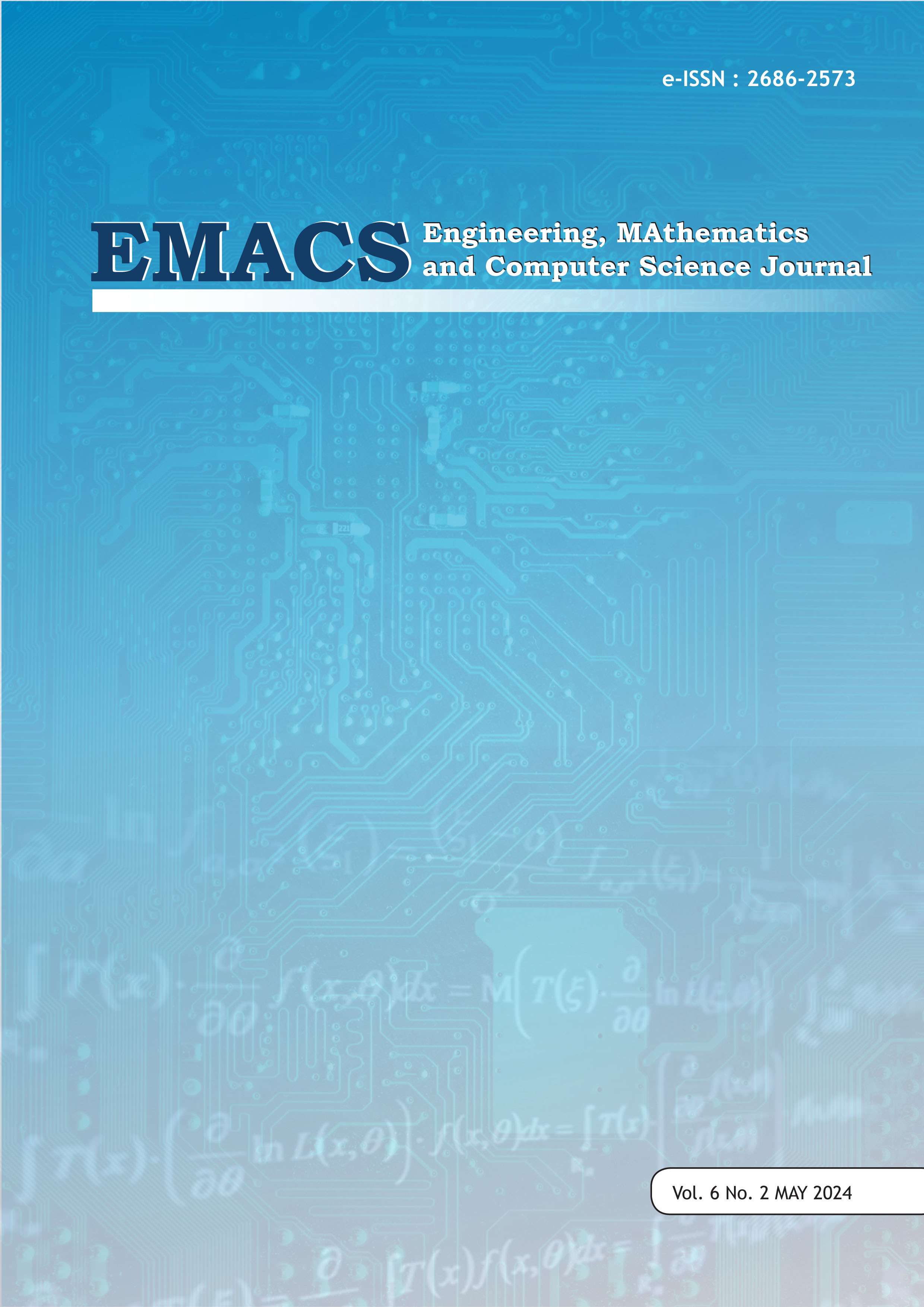Study of Sanitation Infrastructure Operations (Case Study: Wastewater Infrastructure in Ciamis Regency)
DOI:
https://doi.org/10.21512/emacsjournal.v6i2.11671Keywords:
Infrastructure Sanitation, Toilets, WastewaterAbstract
Sanitation infrastructure is intended to complement the needs of people who do not yet have access to wastewater infrasctucture include bathing, washing and toilet. Inadequate sanitation infrastructure in an area can cause problems of decreasing environmental quality in residential areas. Based on data from Ciamis Regency in Figures for 2022, it is stated that the population growth rate is 0.94%, this is one of the problems arising from the rapid population growth and various activities carried out, especially sanitation issues, which are related to domestic wastewater treatment including bathing, washing and toilet bathing facilities or Mandi, Cuci, Kakus (MCK). Ciamis Regency has a total of 63 MCKs that have been built in the 2010-2022 period, spread across 19 sub-districts and 62 villages with 63 MCK units. The results of the assessment of the functioning of the MCK infrastructure in Ciamis Regency show that 37 MCK units are in prime condition, 23 MCK units are damaged but can still function properly, 3 MCK units where users are hesitant to use the MCK. Efforts need to be made to repair damaged and/or non-functioning MCKs by increasing participation from the user community in the form of contributions to MCK managers. This is with the aim that people want to reuse and care for MCK as a form of sense of ownership and shared responsibility.
References
Badan Standardisasi Nasional. (2002). SNI 03-2398-2002 tentang Perencanaan Tangki Septik dengan Sistem Resapan.
Denisa S. P., Nida A. Z. F., Aan J., & Dieny F., (2022). Strategi Peningkatan Kualitas Sanitasi Layak Bagi Rumah Tangga di Kecamatan Sukajadi Kota Bandung. Jurnal Planologi. 19 (1).
Dinas Pekerjaan Umum, Penataan Ruang dan Pertanahan. (2022). Masterplan Air Limbah Domestik Kabupaten Ciamis Tahun 2022. Kabupaten Ciamis.
Elysia, V. (2018). Air dan Sanitasi Dimana Posisi Indonesia. Seminar Nasional Peran Matematika, Sains, dan Teknologi dalam Mencapai Tujuan Pembangunan Berkelanjutan/SDGs, FMIPA Universitas Terbuka, 157–179.
Hari R., Asrori, Hilmi I. F., & Nanang Q. (2021). Penggunaan Jamban/MCK Ditinjau Dari Aspek Kesehatan Lingkungan. Jurnal Ilmiah Teknologi FST Undana 15(1).
Kementerian PUPR. (2022). Buku Saku Petunjuk Konstruksi Sanitasi Pengembangan Infrastruktur Berbasis Masyarakat. Jakarta : Kementerian PUPR, Direktorat Jenderal Cipta Karya, Direktorat Pengembangan Kawasan Permukiman.
Kasey M. F., Dulcy M. A., and Shawn P. M. (2015). Water and Wastewater Infrastructure Management in Shrinking Cities. Public Works Management & Policy. 1 (29).
Kodoatie, Robert J. (2005). Pengantar Manajemen Infrastruktur. Yogyakarta : Pustaka Pelajar.
Pengembangan Prasarana Perdesaan (P2D). (2002). Manual Teknis Pemberdayaan Masyarakat: MCK (Mandi, Cuci, Kakus). Jakarta.
Pusat Penelitian dan Pengembangan Permukiman, Badan Penelitian dan Pengembangan. (2001). Tata Cara Perencanaan Bangunan MCK komunal/umum. Bandung: Kimpraswil, Departemen Permukiman dan Prasarana Wilayah. Departemen Permukiman dan Prasarana,
Prasetyo D. E., Heni Fitriani, Betty Susanti. Analysis of Domestic Wastewater Management Systems in Low Income Residential Areas. Sriwijaya Journal of Environment. 5 (2). 92-102.
Rahmawati, D., Handayani, R. D., & Fauzzia, W. (2018). Hygiene dan Sanitasi Lingkungan di Obyek Wisata Kampung Tulip. Jurnal Pengabdian Kepada Masyarakat. 1(1), 87–94.
Ramadhani, M. R., Fernanda, R., Sari, R., & Lubis, H. (2019). Peran Pola Asuh Orang Tua Dalam Membentuk Karakter Peduli Lingkungan. Psikostudia : Jurnal Psikologi, 7(2), 61.
Ratma, J. N. (2018). Faktor-Faktor Yang Mempengaruhi Penggunaan Jamban Di Desa Blimbing Kecamatan Dolopo Kabupaten Madiun. Sekolah Tinggi Ilmu Kesehatan Bhakti Husada Mulia Madiun. In Analytical Biochemistry.
Saban, L. M. A., et al (2021). Meningkatkan Pengetahuan Masyarakat Dalam Perbaikan Lingkungan Sanitasi. Dinamisa – Jurnal Pengabdian Kepada Masyaakat. 5(1). 10-16.
Sandy, Okka F. (2020). Analisis Peran Aktor dalam Implementasi Kebijakan Pembangunan Sanitasi di Kabupaten Probolinggo. Jurnal Ilmiah Administrasi Publik (JIAP). 6(3), 415-422.
Setyoadi, Nino H. (2011). Pendayagunaan Infrastruktur Sanitasi dan Air Bersih dalam Mendukung Kesehatan Masyarakat (Kasus Kabupaten Gresik, Jawa Timur). Jurnal Sains dan Teknologi Lingkungan. 4(2), 78-87.
Sugiyono. (2013). Metode Penelitian Kuantitatif, Kualitatif dan R&D. Bandung : Alfabeta.CV.
Xu Wang, Glen D. (2018). Evolving Wastewater Infrastructure Paradigm to Enchance Harmony With Nature. American Association for the Advancement of Science
Downloads
Published
How to Cite
Issue
Section
License
Copyright (c) 2024 Suhenra Maulana

This work is licensed under a Creative Commons Attribution-ShareAlike 4.0 International License.
Authors who publish with this journal agree to the following terms:
- Authors retain copyright and grant the journal right of first publication with the work simultaneously licensed under a Creative Commons Attribution License - Share Alike that allows others to share the work with an acknowledgment of the work's authorship and initial publication in this journal.
- Authors are able to enter into separate, additional contractual arrangements for the non-exclusive distribution of the journal's published version of the work (e.g., post it to an institutional repository or publish it in a book), with an acknowledgment of its initial publication in this journal.
- Authors are permitted and encouraged to post their work online (e.g., in institutional repositories or on their website) prior to and during the submission process, as it can lead to productive exchanges, as well as earlier and greater citation of published work.
USER RIGHTS
All articles published Open Access will be immediately and permanently free for everyone to read and download. We are continuously working with our author communities to select the best choice of license options, currently being defined for this journal as follows: Creative Commons Attribution-Share Alike (CC BY-SA)





